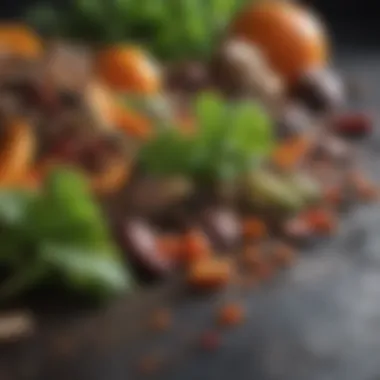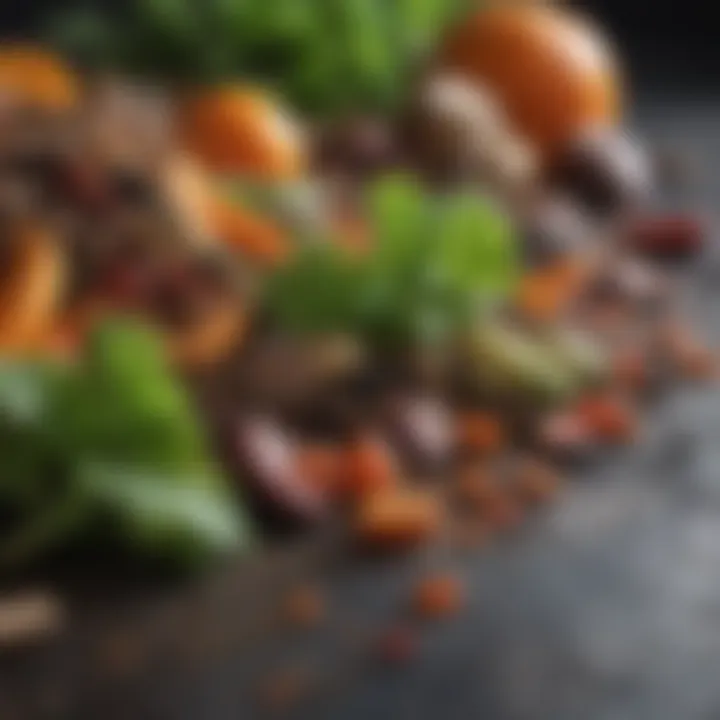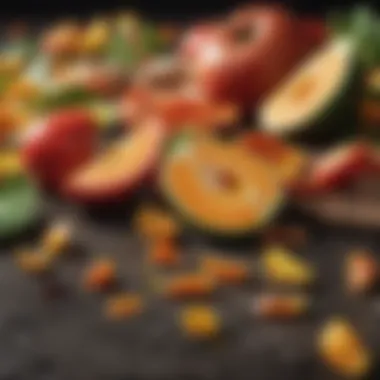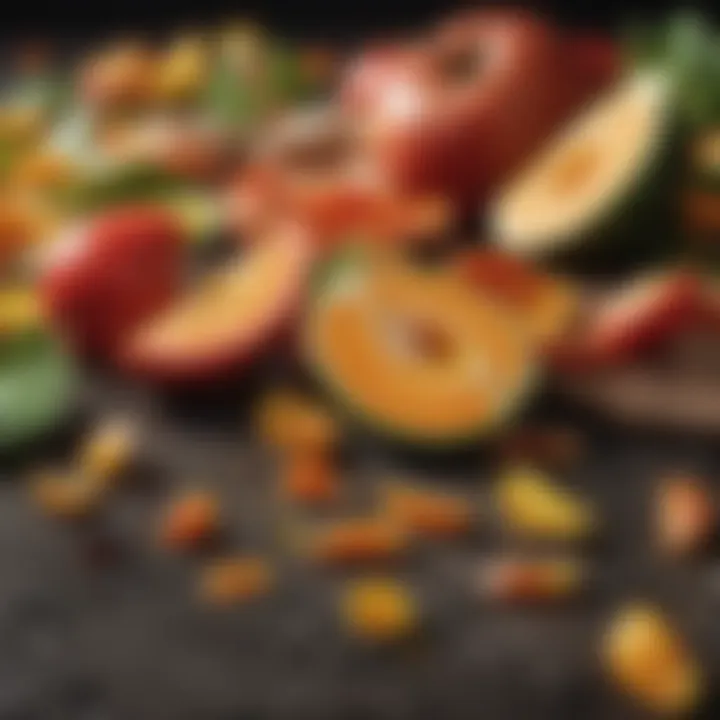Unveiling the Ultimate Food Selection for Effective Composting


Overview of the Topic
Composting, a vital eco-friendly practice, plays a crucial role in waste reduction and soil enrichment. By decomposing organic matter like food scraps and yard waste, composting transforms them into a nutrient-rich soil conditioner. This sustainable process not only reduces landfill burden but also fosters healthier plant growth.
Current Status and Challenges
Despite the numerous benefits of composting, challenges hinder its widespread adoption. Issues such as lack of awareness, space constraints, and concerns about odors and pests pose obstacles. Additionally, improper sorting of compostable materials can lead to contamination, affecting the quality of the end product.
Sustainable Solutions
To overcome these challenges, education and awareness campaigns are essential. By educating communities about the benefits of composting and providing guidance on proper composting techniques, more individuals can participate in this eco-conscious practice. Implementing community composting programs and offering incentives for households can also boost composting rates.
Impact and Importance
The impact of composting extends far beyond individual gardens. By diverting organic waste from landfills, composting significantly reduces methane emissions, a potent greenhouse gas. Furthermore, the nutrient-rich compost generated enhances soil fertility, reduces reliance on chemical fertilizers, and promotes sustainable agriculture practices for future generations.
Introduction
In the realm of sustainable practices, composting stands out as a fundamental pillar of environmental conservation. By repurposing organic waste into nutrient-rich soil enhancer, composting not only reduces the burden on landfills but also fosters a circular economy beneficial for both ecosystems and human well-being. As we delve into the dynamics of composting in this article, we aim to illuminate the significance of selecting the optimal food items that contribute to the efficacy of the composting process.
To comprehend the essence of composting is to acknowledge its multifaceted benefits. From diminishing greenhouse gas emissions associated with organic waste decomposition in landfills to cultivating a more fertile ground for plant growth, the practice of composting embodies a harmonious relationship with nature. By recognizing the value of composting not merely as a means of waste management but as a catalyst for sustainable agriculture and ecological balance, we are propelled towards a more conscious and responsible stewardship of the environment.
Through a nuanced exploration of the best food components for compost, we illuminate not only the practical aspects of composting but also the philosophical undertones of mindful consumption and waste utilization. With an emphasis on the synergistic interactions between fruit and vegetable scraps, coffee grounds, eggshells, tea bags, grass clippings, leaves, and shredded paper, we unveil the intricate web of organic materials that converge to create a fertile composting ecosystem. By discerning the innate value of each food item for compost production, we equip ourselves with the knowledge to harness the regenerative potential of our everyday organic discards.
As we embark on this journey of understanding the symbiosis between food waste and compost enrichment, we pave the way for a deeper appreciation of the interconnectedness of all living entities within the biosphere. By embracing the best food choices for compost, we not only nourish our soils but also nurture a paradigm shift towards a more holistic and sustainable coexistence with our planet.
Overview of Composting
Composting, a fundamental process in the realm of sustainability and environmental stewardship, holds immense significance in the journey towards a greener future. Understanding the intricate workings of composting is crucial for individuals and communities looking to minimize waste, enrich soil health, and reduce their ecological footprint. By breaking down organic matter into nutrient-rich humus, composting not only diverts waste from landfills but also enriches soil fertility, supporting healthy plant growth and biodiversity. Through the meticulous management of compost piles and bins, individuals can actively contribute to a circular economy that promotes resource efficiency and ecosystem resilience.


Definition of Composting
Composting can be defined as the natural biological decomposition of organic material by microorganisms under controlled conditions. This process transforms kitchen scraps, yard waste, and other organic matter into a valuable soil amendment known as compost. In essence, composting mimics nature's way of recycling nutrients, where bacteria, fungi, insects, and other decomposers work harmoniously to break down complex organic compounds into simpler forms that plants can readily absorb. Harnessing the power of decomposition, composting not only reduces methane emissions from landfills but also fosters the regeneration of nutrient cycles within ecosystems.
Benefits of Composting
The benefits of composting extend far beyond waste reduction and soil enrichment. By incorporating compost into soil, individuals can improve its structure, water retention capacity, and nutrient content, leading to healthier plants and increased crop yields. Furthermore, compost acts as a natural soil conditioner, helping to balance pH levels and suppress plant diseases. From promoting beneficial microbial activity to sequestering carbon and reducing the need for synthetic fertilizers, composting offers a myriad of advantages for both agricultural and residential settings. Embracing composting practices can foster sustainable landscapes, reduce reliance on chemical inputs, and mitigate environmental degradation.
Environmental Impact of Composting
Composting plays a pivotal role in mitigating climate change and conserving natural resources. By diverting organic waste from incineration or landfills, composting helps to mitigate greenhouse gas emissions and minimize leachate pollution. The nutrient-rich compost produced serves as a carbon sink in soils, enhancing soil biodiversity and resilience to environmental stressors. Additionally, compost-amended soils exhibit higher water holding capacity, reducing the risk of erosion and promoting plant drought tolerance. From supporting regenerative agriculture to fostering biodiversity conservation, composting stands as a cornerstone practice in sustainable waste management and ecosystem restoration.
Key Components for Successful Composting
Composting is a meticulous process that involves a variety of key components essential for its success. Among these components, organic waste plays a pivotal role. Organic waste, such as fruit and vegetable scraps, coffee grounds, eggshells, tea bags, grass clippings, leaves, and shredded paper, provides the necessary nutrients for the decomposition process. These materials are rich in carbon and nitrogen, crucial elements for the growth of beneficial microorganisms that break down the waste into nutrient-rich compost. Maintaining a balance between carbon-rich ("browns") and nitrogen-rich ("greens") materials is vital to ensure a healthy compost pile. Moreover, organic waste helps reduce landfill waste, minimizing greenhouse gas emissions and supporting sustainable waste management practices.
Organic Waste
Organic waste is the backbone of successful composting. It comprises biodegradable materials that can be broken down into compost through microbial activity. Fruit and vegetable scraps are excellent sources of nitrogen, aiding in the decomposition process. Coffee grounds add a significant amount of nitrogen to the compost, while also improving its texture. Eggshells provide calcium, a vital nutrient for plant growth, and help balance the acidity levels in the compost. Tea bags break down quickly, contributing nitrogen and trace minerals. Grass clippings are high in nitrogen and offer essential moisture retention to the compost. Leaves are a good source of carbon, maintaining aeration and preventing the pile from becoming too compact. Shredded paper is rich in carbon, balancing the nitrogen content in the compost. Together, these organic materials create a nutrient-dense environment for microbial activity, fostering the breakdown of waste into a valuable soil amendment.
Moisture Level
Maintaining the proper moisture level in a compost pile is crucial for the decomposition process. Adequate moisture ensures that beneficial microorganisms remain active, breaking down organic matter effectively. Compost should ideally have a moisture content of around 50-60%, resembling a damp sponge. Too much moisture can lead to anaerobic conditions, resulting in a foul odor and slowing down decomposition. On the other hand, insufficient moisture can impede microbial activity, prolonging the composting process. Monitoring and adjusting the moisture levels by adding water or dry materials, as needed, is essential for efficient composting. Additionally, covering the compost pile during heavy rains or providing drainage to prevent waterlogging helps maintain the optimal moisture balance.
Aeration
Aeration is another critical aspect of successful composting. Oxygen is necessary for microbial activity, allowing aerobic bacteria to thrive and break down organic materials efficiently. Proper aeration prevents the compost pile from becoming compacted, ensuring that oxygen reaches all parts of the pile. Turning the compost regularly with a pitchfork or a compost aerator promotes aeration and mixes the materials, enhancing decomposition. Creating layers within the compost pile, alternating between browns and greens, facilitates airflow and improves aeration. Monitoring the temperature of the compost pile can also indicate whether sufficient aeration is present, as microbial activity generates heat. By maintaining adequate aeration, composters can accelerate the decomposition process and produce high-quality compost for enriching soil fertility and enhancing plant growth.
Best Food Items for Compost
In the realm of composting, the selection of appropriate food items plays a crucial role in the successful decomposition process. Understanding the significance of choosing the best food for compost is paramount to achieving optimal compost production and nurturing a healthy environment. By incorporating a variety of organic materials into your compost pile, you can facilitate the breakdown of waste into nutrient-rich soil amendment while reducing landfill waste and promoting sustainability. This section will delve into the specific elements, benefits, and considerations regarding the best food items for compost, shedding light on the key ingredients that contribute to an effective composting regimen.


Fruit and Vegetable Scraps
Fruit and vegetable scraps are valuable additions to any compost pile due to their high nutrient content and relatively quick decomposition rate. These scraps include peels, cores, rinds, and trimmings from a wide array of fruits and vegetables, providing essential organic matter that fosters microbial activity and accelerates the composting process. When adding fruit and vegetable scraps to your compost, it's advisable to chop them into smaller pieces to expedite breakdown and ensure efficient incorporation into the pile. Moreover, maintaining a balanced mix of green (nitrogen-rich) and brown (carbon-rich) materials is essential to promoting decomposition and minimizing odors in the compost heap.
Coffee Grounds
Coffee grounds are a rich source of nitrogen, making them a valuable component for compost enrichment. When incorporated into your compost pile, coffee grounds contribute to microbial growth, enhance soil structure, and increase nutrient availability for plants. Additionally, coffee grounds help to neutralize odors and deter pests, further enhancing the composting process. To optimize the benefits of coffee grounds in compost, it is advisable to mix them with other organic materials, such as leaves or shredded paper, to maintain a balanced carbon-to-nitrogen ratio and promote efficient decomposition.
Eggshells
Eggshells are a beneficial addition to compost due to their calcium content, which can help to balance the pH levels of acidic compost materials. When crushed before adding to the pile, eggshells break down more rapidly, releasing calcium into the soil and enhancing nutrient availability for plants. Incorporating eggshells into your compost also helps to deter pests like slugs and adds valuable organic matter to the mix. To maximize the benefits of eggshells in compost, it is recommended to rinse them thoroughly, crush them into small pieces, and layer them within the compost heap to ensure even distribution and efficient decomposition.
Tea Bags
Tea bags are a convenient composting material that can enrich the nutrient content of your compost pile. Made from biodegradable materials such as paper and natural fibers, used tea bags decompose quickly and add beneficial organic matter to the soil. Tea leaves, which are rich in tannins and nutrients, can boost microbial activity in the compost, supporting the breakdown of organic materials and the release of essential nutrients for plant growth. To include tea bags in compost, simply remove any metal staples or tags, tear open the bags to release the tea leaves, and mix them evenly into the compost pile for optimal decomposition.
Grass Clippings
Grass clippings serve as a valuable nitrogen source for compost, contributing to the heat-generating properties of the pile and aiding in the decomposition of carbon-rich materials. When grass clippings are added to compost, they introduce moisture and nitrogen that promote microbial activity and accelerate the breakdown of organic matter. To effectively incorporate grass clippings into your compost, it is recommended to mix them with dry, brown materials like leaves or shredded paper to maintain a balanced carbon-to-nitrogen ratio and prevent matting. Regularly turning the compost heap will help aerate the mixture and enhance the decomposition process.
Leaves
Leaves are an excellent carbon-rich addition to compost that helps balance the nitrogen content from green materials like fruit and vegetable scraps or grass clippings. Incorporating leaves into your compost pile not only provides essential carbon for microbial activity but also helps create air pockets that improve aeration and moisture retention in the heap. Shredded leaves decompose more rapidly than whole leaves, allowing for quicker breakdown and integration with other compost materials. When including leaves in compost, ensure they are free from disease or pesticides, as these can hinder the composting process and impact the quality of the final compost product.
Shredded Paper
Shredded paper serves as an excellent carbon source for composting, offering a convenient way to recycle paper waste and enrich your compost pile. When added to compost, shredded paper provides structure, absorbs excess moisture, and creates pathways for airflow within the pile. Mixing shredded paper with nitrogen-rich materials like fruit and vegetable scraps or grass clippings helps maintain a balanced carbon-to-nitrogen ratio, supporting efficient decomposition and odor control in the compost heap. To include shredded paper in compost, tear or shred paper into small pieces, avoid glossy or colored paper, and layer it evenly with other compost materials to ensure thorough integration and decomposition.
Items to Avoid Adding to Compost


Composting is a delicate process that requires balance and careful selection of materials to ensure the optimal breakdown of organic matter. To maintain a healthy and efficient compost pile, it is crucial to be mindful of the items that should be avoided to prevent potential issues such as foul odors, attracting pests, or disrupting the decomposition process. By understanding what not to include, you can steer clear of common pitfalls and promote a successful composting experience.
Meat and Dairy Products
Meat and dairy products are considered composting faux pas as they can introduce harmful pathogens, produce unpleasant odors, and attract unwanted critters to your compost pile. These materials decompose slowly and are prone to creating imbalances in the nutrient composition of the compost, hindering the breakdown process. Therefore, it is advisable to refrain from adding meat scraps, bones, cheese, and other dairy items to your compost bin to maintain a healthy and odor-free composting environment.
Greasy or Oily Foods
Incorporating greasy or oily foods such as leftover fried foods, salad dressings, or greasy residues can impede the aeration and moisture levels within the compost pile. These substances tend to clump together, restricting airflow and promoting the growth of anaerobic bacteria, which thrive in low-oxygen environments. As a result, adding greasy or oily foods can lead to foul-smelling compost and hinder the overall decomposition process. It is best to avoid introducing such items to uphold a well-balanced and thriving compost ecosystem.
Citrus Peels
While citrus peels may seem biodegradable, they contain natural oils and chemicals that can disrupt the pH levels of the compost pile. Adding citrus peels in large quantities can make the compost overly acidic, inhibiting the activity of essential decomposers like bacteria and worms. Furthermore, citrus peels take longer to break down compared to other organic materials, potentially slowing down the composting process and causing imbalance in the nutrient content. It is recommended to limit the inclusion of citrus peels in compost and opt for alternative compostable materials to maintain a harmonious decomposition environment.
Pet Waste
Pet waste, such as feces from cats, dogs, or other animals, should be avoided in compost bins due to the presence of harmful pathogens and parasites. Including pet waste can introduce diseases into the compost that may not be fully eliminated during the composting process, posing health risks when using the finished compost in gardens or on plants. To safeguard both the integrity of the compost and protect against potential health hazards, it is advisable to refrain from adding pet waste to your compost pile. By being selective in the materials you incorporate, you can prioritize the health and productivity of your compost while fostering a sustainable and thriving ecosystem.
Maintaining Your Compost Pile
In the realm of composting, maintaining your compost pile is a crucial aspect that cannot be overlooked. The proper upkeep of your compost pile ensures its efficiency and effectiveness in breaking down organic material into nutrient-rich compost for your garden. By focusing on maintaining your compost pile, you are essentially nurturing the environment within the pile to encourage the decomposition process. It involves a combination of specific actions and considerations that play a significant role in the success of your composting endeavors.
When it comes to turning and mixing your compost pile, you are essentially aiding in the aeration and redistribution of organic matter within the pile. Turning the compost helps introduce oxygen into the pile, which is vital for the growth of beneficial microorganisms responsible for decomposition. Mixing the compost materials ensures that all components are well distributed, promoting uniform decomposition and preventing pockets of anaerobic decomposition that can lead to unpleasant odors. By paying attention to this aspect of compost maintenance, you are actively fostering a healthy environment for the breakdown of organic matter into valuable compost.
Monitoring the temperature of your compost pile is a pivotal aspect of maintaining optimal conditions for decomposition. A well-functioning compost pile generates heat as microorganisms break down organic matter. Monitoring the temperature allows you to determine if the pile is decomposing efficiently. Ideally, the temperature of a compost pile should range between 110-140 degrees Fahrenheit (43-60 degrees Celsius) for optimal decomposition. Understanding the temperature dynamics within your compost pile enables you to make adjustments as needed, such as adding more bulky materials to increase heat or introducing more moisture to cool the pile down. By closely monitoring the temperature, you can ensure that the decomposition process is proceeding smoothly and effectively.
Ensuring proper airflow within your compost pile is essential for fostering the growth of aerobic bacteria, which are responsible for the decomposition of organic matter. Adequate airflow prevents the development of anaerobic conditions that can slow down the decomposition process and lead to a foul-smelling compost pile. By regularly turning the pile and incorporating materials that promote airflow, such as straw or shredded paper, you can create an environment conducive to aerobic decomposition. Proper airflow not only speeds up the composting process but also helps maintain a pleasant smell in your compost pile, indicating that decomposition is occurring efficiently. By prioritizing proper airflow, you are setting the stage for successful composting and the production of nutrient-rich compost for your gardening endeavors.
Conclusion
One of the pivotal elements emphasized throughout this exploration is the role that food waste plays in compost production. Fruit and vegetable scraps, coffee grounds, eggshells, tea bags, grass clippings, leaves, and shredded paper serve as valuable inputs in creating nutrient-rich compost, essential for enriching soil fertility and supporting plant growth. By incorporating these organic materials into compost piles, enthusiasts align themselves with the principles of circular economy, where resources are recycled and reused in a closed-loop system.
Moreover, the benefits of composting extend beyond bolstering soil health and plant vitality. Composting aids in combating climate change by reducing methane emissions from landfills, offering a natural solution to waste management while sequestering carbon in the soil. This process not only enhances agricultural practices but also promotes biodiversity, as healthy soil ecosystems support a myriad of beneficial organisms essential for Earth's vitality.
As conscientious conservationists, students, and environmentalists delve into the art of composting and investigating the most suitable food items to include, they not only participate in a sustainable endeavor but also contribute to a larger movement towards eco-conscious living. The meticulous selection of food scraps, diligent monitoring of compost piles, and regular maintenance practices pave the way for creating nutrient-dense compost, enriching gardens, landscapes, and urban green spaces.
In essence, by embracing the recommendations outlined in this article and incorporating the best food for compost into daily waste management routines, individuals can take proactive steps towards fostering a harmonious relationship with nature, nurturing the planet, and securing a greener future for generations to come.



